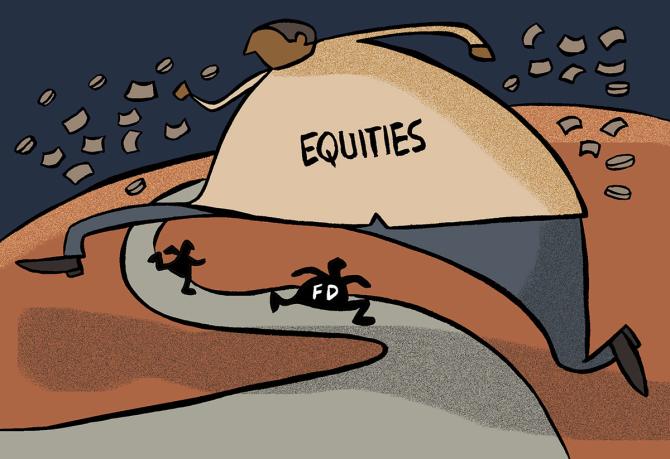Retail investors have become a force to reckon with in the last 10 years with their ownership of Indian equities rising 800 basis points, or 8 per cent, to 23.4 per cent during this period, suggests a recent note from Morgan Stanley.

This number, Morgan Stanley said, is set to rise in the next few years as Indian households are still underinvested in equities.
India's demographics, policy framework, investor education and modest positive real rates, it said, will fuel the 'equity cult' in India.
“At cost, only 3 per cent of the household balance sheet is in equities (excluding founders’ equity holdings).
"This number could rise to double digits.
"If one looks at the wealth creation of the past decade (we estimate households have added $8.5 trillion in wealth), about 11 per cent has come from equities.
"This disproportionate share of equities in wealth accretion further underscores our opinion,” wrote analysts at Morgan Stanley led by Jonathan F Garner, their chief Asia and emerging market strategist.
Though Morgan Stanley expects market and corporate activity to rise in the coming years, equity market returns are likely to moderate in the next 10 years, and are likely to compound in low double digits.
“With equity issuances just off lows, and a capex cycle in front of us, we expect equity issuances to make a new high (previous high was 3.5 per cent of market capitalization in 2009) in the coming five years.
"Corporate borrowings both from banks and the bond markets are set to rise after dipping to cycle lows last year,” Morgan Stanley said.
Adding: "A new high in the coming five years is our base case.
"At the same time, market trading activity both in cash and derivatives is likely to rise as market participants churn portfolios more aggressively over the next few years – a telltale sign that the bull market is gaining momentum towards maturity.”
Corporate earnings & FII flows
India Inc's earnings, Garner believes, are underpinned by an emerging private capex cycle, releveraging of corporate balance sheets, and unfolding of a structural rise in discretionary consumption.
Earnings outlook, he said, makes Indian equity valuations tolerable.
Trend earnings, he said, are still below nominal GDP, so the cycle has room to the upside and forecasts 18-20 per cent earnings CAGR for the next 4-5 years, which in turn can drive the market higher.
Household assets in equities
These positives, according to Morgan Stanley, will continue to attract foreign investors to Indian equities.
That apart, rising index weights, too, make India's equity market a compelling story and hard for investors - both active and passive - to avoid.
"Bond flows due to India’s inclusion in the bond index should help keep the external situation in good stead.
"India has proven to be a fruitful market for private equity, venture capital funds and sovereign funds that have managed profitable exits in recent years - we expect this cohort will also step up activity," Garner wrote.
Key risks
Though the stars are aligned favourably for the Indian markets, there are some risks as well.
Longer term, India, according to the Morgan Stanley note, faces capacity constraints in the bureaucracy, the judiciary, healthcare, education, and skills training, while other risks include geopolitics, artificial intelligence’s (AI's) effects on the tech industry, low productivity in the farm sector, climate change, state-level fiscal challenges, and a lack of adequate factor reforms.
Valuations of Indian markets, especially metrics such as market-cap to GDP, appear to be stretched, Garner cautions.
In addition, there could be bunching up of equity issuances as Corporate India takes the capex cycle forward in earnest.
“Several small-and mid-cap (SMID) stocks look overvalued, but we do not share the concern on overall market valuations given our view that we are still in the middle of the earnings cycle.
"In the near term, a tight policy environment (fiscal plus monetary) could risk growth, especially if the world slows down.
"A substantial global growth slowdown or a sharp rise in oil prices could hurt India’s growth as well as funding,” Garner wrote.












 © 2025
© 2025